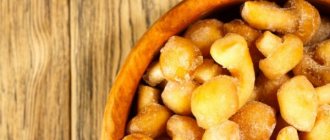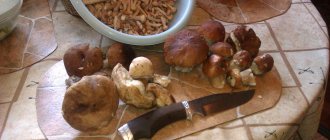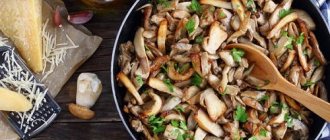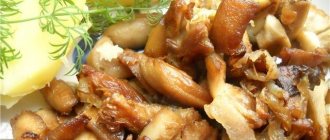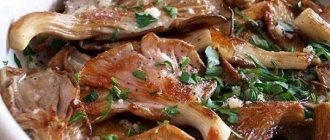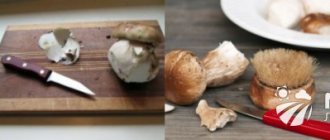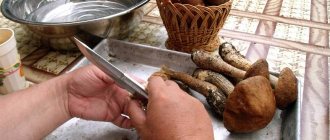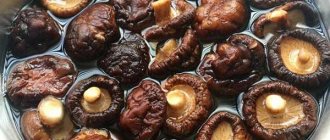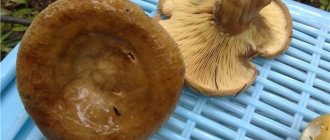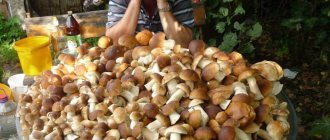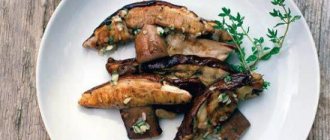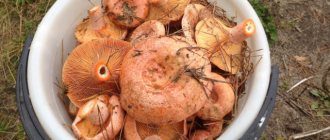Experienced mushroom pickers treat a walk in the forest as a certain ritual. Families can spend hours walking and picking mushrooms, and at home carefully and lovingly clean them. They pay special attention to each one and wash them thoroughly. But not everyone knows how to process mushrooms correctly. If there are doubts about the quality, the product should not be consumed under any circumstances; it is better to throw it away immediately.
Cleaning mushrooms from debris
Mushrooms spoil very quickly, so you need to prepare them for storage quickly. A walk in the forest is a tiring activity; after returning home you want to lie down and relax. How to process mushrooms in the forest? To save time, it is worth starting processing immediately after they are picked. To do this, you need to clean each mushroom from debris and leaves, and if the skin on the cap is easily removed, then it can be removed. The mucous top must be cleaned and the film removed. Naturally, in the forest you need to spend more time walking, but at home you can relax a little.
Cooking mushrooms is very easy
You need to put it in a saucepan, add a small amount of water, add salt and, after boiling, keep it in boiling water from five minutes to one hour, depending on the type. If mushrooms are processed for further frying, they need to be cooked for 10 - 20 minutes less than indicated in the basic recommendation. Then remove from the water, chop or grind in a meat grinder and use according to the main recipe.
A very tasty winter preparation will be made from boiled fresh mushrooms prepared according to the following recipe.
Ingredients :
- two kilograms of fresh mushrooms;
- one and a half liters of water;
- a spoonful of salt (the amount of salt can be varied to suit your taste);
- two black currant leaves;
- head of garlic;
- ten black peppercorns.
Preparation
- First, you need to sort the mushrooms, clean off the forest dirt, and rinse them in small portions in a colander.
- In a large bowl or saucepan, soak the entire amount of mushroom “meat” and add a portion of fresh cold water.
- Place a small pressure in the form of a plate of suitable diameter so that all the mushrooms are under water.
- After an hour and a half, rinse the soaked mushrooms again, chop the large ones, and leave the small ones whole.
- Pour one and a half liters of water over the mushrooms and bring to a boil over high heat.
- As soon as the water boils, reduce the heat, add pepper and salt, currant leaves and garlic.
- Cook for 20 minutes, then remove the mushrooms with a slotted spoon and cool.
For winter freezing, place the cooled mushrooms in bags in small portions of about half a kilogram (exactly as much as you need for mushroom soup, frying with potatoes, making a pie, etc.) and place in the freezer. It is important that there is as little air as possible left in the bag of mushrooms.
https://www.youtube.com/watch?v=channelUCepCBVe_flppg7YKvG7VVmQ
Mushrooms frozen this way can be stored for one year.
Preparing mushrooms
After arriving home, you should immediately distribute them by type to make it easier to figure out how to process mushrooms and what to cook from them. Then you need to take a sharp knife and cut out all the dark places, and also check the product for the presence of insects or worms. The caps must be carefully wiped with a brush or brush, and then the tip of the stem must be cut off.
When all the mushrooms are cleaned, they should be washed thoroughly. But this must be done with extreme caution, since a long stay in water will not have the best effect on the quality, and their taste will change slightly. The mushrooms must be placed in a colander and rinsed a little with cold water, and then allowed to drain.
If you know how to properly process mushrooms, then the juice that remains should not be thrown away. It can be used to prepare other dishes.
If there are a small number of wormholes on the mushrooms, the product should be soaked in cold water, after adding salt. Then the worms will come out and remain in the container with water. In the case where the mushroom is very difficult to wash, since it is excessively contaminated, it can be placed in water and left for some time.
It is more convenient to wash in a basin or in a large saucepan. It is important that the mushrooms are covered with water. To prevent them from floating up, you can put plywood or a board with a small weight on top. Once the leaves and other debris are soaked, it will be very easy to separate them.
Those mushrooms that are intended for pickling must be soaked. For milk mushrooms, you should scrape off the top black layer with a knife, and for buttermilks, remove the films from the caps. When thinking about how to process volushka mushrooms, you should remember that they are soaked raw and then pickled.
Those species that contain milky bitter juice need to be soaked for 2-3 days, changing the water at least three times a day. It is better to place the container in a cool place so that the mushrooms do not sour.
Experienced mushroom pickers claim that soaking is not as beneficial as is commonly believed. This is due to the fact that along with bitterness, nutrients and protein substances leave, the nutritional value of the product decreases, and the mushroom becomes soft and flabby. Therefore, experts do not recommend soaking for more than 2 days. If you figure out how to process mushrooms, then after cooking they will always turn out delicious.
When sorting, you need to pay special attention to whether there are any poisonous species in the basket. Some toadstools are very similar to russula. You can distinguish them by their stem: if the russula is real, its stem is straight to the very base, while in a false mushroom it expands downward. It will also be useful for beginners to know that the skin of the toadstool cap is removed from the edge to the center. If there are doubts about the quality, you should never use them; it is better to throw them away immediately. You should not collect those mushrooms that grow near highways or landfills: they can cause severe poisoning.
Heat treatment
Heat treatment eliminates mushroom toxicity
The purpose of the process is to eliminate the bitterness or toxicity of some specimens. The rules for processing conditionally edible mushrooms provide for the mandatory implementation of the following manipulations.
Boiling
Mushrooms are cooked for 15-30 minutes. The fruiting bodies are boiled in a large amount of water, but after that they lose a certain part of the nutrients. The smell becomes weaker and the taste changes, so if possible you should skip this process. The following types are used without heat treatment:
- White mushrooms;
- chanterelles;
- Champignon;
- honey mushrooms summer and autumn;
- most russula, etc.
Many types become viscous after boiling. In some fruiting bodies, only the legs have this feature. They are cut off from mushrooms, leaving only the caps.
During cooking, be sure to remove any foam that appears from the surface.
Boiling
To perform heat treatment of mushrooms, proceed according to the following recommendations:
- pour cold salted water so that it covers the mushrooms;
- bring to a boil and immediately remove from heat;
- leave in the broth until it cools or pour cold water over it.
Squeezing fruiting bodies is prohibited. Otherwise, this will lead to the loss of many beneficial substances.
Blanching
Using scalding, one achieves the preservation of the integrity and elasticity of the specimens.
The method is suitable for russula with a large flat cap, saffron milk caps, and autumn boletus. The essence of the technological process lies in the following actions:
- washed mushrooms are placed in a colander;
- pour boiling water over it or dip it in boiling water or place it in a steam bath for a few minutes.
Pickling
Most often, tubular types that do not contain bitterness are pickled. Small mushrooms are marinated separately, and large ones should be cut into pieces. The legs need to be separated from the caps, and they can be marinated either together or separately. Mushroom pickers advise selecting the caps and using the stems for preparing other dishes.
If the boletus is young, it is necessary to remove the lower film. It is more convenient to do this with the tip of a thin knife. The stem should be left a couple of centimeters from the cap.
Those mushrooms that will be pickled cannot be washed, as they will absorb water, which is extremely undesirable. It is better to wipe them with a damp cloth.
Taste qualities of the product
Most likely, everyone has heard about the significant nutritional, and in some cases even medicinal properties of this mushroom. But at the same time, they have earned genuine love and fame precisely because of their excellent culinary properties. The spectacular aroma and recognizable taste of such mushrooms make them an excellent product for preparing certain dishes or as an additive as an ingredient in dishes with a richer composition of ingredients. Whatever is prepared from these popular gifts of the forest! From them and with their participation they make:
- pickles;
- stewing;
- frying;
- marinades.
They are also baked, dried, ground into powder, etc. The mushroom is equally good in a variety of forms. And its incomparable aroma, like no other, perfectly emphasizes the taste properties of fried chicken, baked beef, buckwheat or stewed pork. During poor harvests or in winter, well-marinated or salted strong porcini mushrooms will become a dear guest at any feast in honor of any celebration.
How to dry mushrooms?
To dry the product, you need to know how to process fresh mushrooms. A product that is not properly prepared for storage will quickly deteriorate. For drying, tubular types (white, boletus, boletus) or lamellar (russula, honey mushrooms or chanterelles) are most suitable.
It is better to dry strong, not old mushrooms without damage. They should never be soaked or washed. To remove dirt and debris, use a damp cloth. Mushrooms are dried separately for each type, if necessary, cut into pieces. Hats can also be divided into parts. In order for the mushrooms to dry faster, their thickness should be 3-5 mm. Cut conveniently with a sharp knife, placing the spongy side up.
Preparation for the winter
During the harvesting process, mushrooms undergo two cooking processes: pre-treatment over fire and in marinade.
It is important to consider that with prolonged cooking, mushrooms lose their taste and fall apart.
Experienced housewives answer the question of how long to cook porcini mushrooms until tender:
- Initially, they are kept in boiling water for 15 minutes from the moment the water boils.
- All foam from the surface must be removed. Already in the marinade they are boiled for another 15 minutes.
- The total time is enough to produce a high-quality product.
The broth can be frozen and used as a semi-finished product when preparing sauces, gravies or soups. This is done in several steps:
- Cooking time depends on the condition of the mushroom (from 20 to 40 minutes).
- Place a plastic bag in a clean mayonnaise bucket.
- The broth is poured in. You need to leave a small margin to the edge, since the liquid expands as it freezes.
- The bucket goes into the freezer.
- The frozen liquid is removed from the mold and stored in a bag until required.
For freezing, prepare a concentrated broth at the rate of 200 g of mushrooms per 500 ml of water.
Preparing porcini mushrooms
They are very tasty, nutritious and are highly respected by chefs. But not everyone knows how to process porcini mushrooms. First of all, use a small knife to trim the tip of the stem, grabbing a little on the sides to remove foreign particles.
Use a paper towel to wipe the mushroom and remove small particles of debris. If drying is intended, the product should not be wetted.
To check if the mushroom is wormy, you need to trim the stem. If the caps are very large, you can cut them into pieces. In cases where the contamination is very strong, it is necessary to boil the product for some time or soak it in salt water.
When thinking about how to process porcini mushrooms, you should use a toothbrush. It removes debris well and does not damage the cap.
Features of the species
Fragrant and appetizing boletus and aspen mushrooms have always been an integral food product in Russia. Despite the fact that both types are similar to each other, they still have significant differences.
boletus
Walking through a birch grove, especially in places where the sun warms the ground well, you can often find a boletus mushroom - tall, slender, on a long leg and wearing a beautiful convex hat, which over time becomes like a pillow. Its diameter can reach 15 cm. In its appearance, the boletus mushroom resembles a porcini mushroom, but unlike it, the boletus leg is covered with small gray or black scales.
The color of the fruit varies depending on the place of growth and can be from light beige to black and brown. There are several types of boletus: Common, Swamp (or White), Black, Pinkish, Tundra, Hard, Gray and Multi-colored.
You may be interested in:
What the boletus mushroom looks like and its description (24 photos) The bright dense cap, reminiscent in color of autumn foliage, the thick stem, impressive size and pleasant taste made...Read more...
The most common boletus is the common boletus. It is recognized by its uniform color and stem, which thickens at the bottom. They love it not only for its taste. Boletus cleanses the body of toxins, has a positive effect on the nervous state, regulates blood sugar, helps with kidney problems, has a beneficial effect on the skin and is not high in calories (only 20 kcal per 100 g) and is rich in various microelements necessary for the body.
Boletus
In mixed forests and aspen groves you can find mushrooms with bright red caps and a stocky stalk covered with scales. These are boletuses. They received this name because of their color, which is very reminiscent of the autumn foliage of aspen.
But contrary to popular belief that these mushrooms grow only near aspen trees, they can be seen under oaks, lindens, poplars, willows and other trees. They also love to live in a humid environment among moss, blueberry bushes, grass and ferns.
There are several types of boletuses. The most famous are: Red, Painted Legs, White and Oak. Boletuses are very valuable for their healing properties. It is believed that they cleanse the blood, help reduce cholesterol, remove heavy metal salts, poisons and radionuclides, have an antitumor effect, help normalize the intestinal microflora, and increase immunity.
Useful properties of oil
Butter is an excellent low-calorie product. They contain only 19 kcal per 100 g. fresh product. And besides, they are digested rather slowly, and therefore leave a feeling of fullness in the stomach longer. For all these reasons, butternut squash is a great food for people looking to lose weight.
- Due to their high protein content, boletus serves as a good meat substitute for people following a vegetarian diet.
- Due to the substances they contain, boletus has a restorative effect on the human body, strengthens the immune system and helps resist viral and colds.
Maslyata is an excellent choice when you need to prepare a tasty and satisfying mushroom dish. There are a huge number of recipes for wonderful dishes made from these mushrooms, and anyone can replenish this piggy bank by happily experimenting in the kitchen with these tasty and affordable inhabitants of pine forests.
